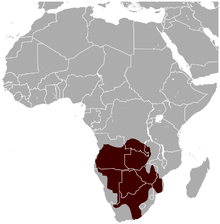Pedetes capensis
| South African springhare Temporal range: Early Pliocene–Recent |
|
|---|---|
 |
|
| Scientific classification | |
| Kingdom: | Animalia |
| Phylum: | Chordata |
| Class: | Mammalia |
| Order: | Rodentia |
| Suborder: | Anomaluromorpha |
| Family: | Pedetidae |
| Genus: | Pedetes |
| Species: | P. capensis |
| Binomial name | |
|
Pedetes capensis (Forster, 1778) |
|
 |
|
| South African springhare range. | |
| Synonyms | |
|
Pedetes cafer |
|
Pedetes cafer
Pedetes caffer
The South African springhare (Pedetes capensis), or springhaas in Afrikaans, is not actually a hare, but a rodent. It is one of two living species in the genus Pedetes, and is native to southern Africa. Formerly, the genus was considered monotypic and the East African springhare (P. surdaster) was included in P. capensis. Though the species look alike at a casual glance, scientific study can easily determine which is which.
The springhare resembles a small kangaroo (though unrelated) with well-developed hind legs, which allows it to leap over 2 m (6 ft 7 in) in a single bound. It gets its name from this ability. This animal grows to be around 35–45 cm (14–18 in) in length excluding its long tail, and weighs an average of 3 kg (6.6 lb). The tail adds to another 36–47 cm (14–19 in) in length. The colour of this mammal varies from a reddish-brown to a pale grey, with a black tip on the tail. The springhare lives only in south-eastern Africa, feeding on plant matter and even occasionally insects. They have four toes on their hind feet with claws that look like small hooves; these are wider than those found on the fore feet. They have a thick, muscular neck supporting their short head. They also have large eyes, and their ears have a tragus that prevents sand from entering when they are digging.
Springhares breed throughout the year. The females give birth to a single young about three times a year. Unlike some other rodents, which have blind and hairless young, springhares are born furred, and are active within a very short time of birth. However, they are not weaned and do not leave the burrow until they are about half grown. This extended period of parental care helps to mitigate a birthrate that is, among rodents, remarkably low.
Springhares are mostly nocturnal, but are occasionally active in the day. During the daytime, they live in tunnels that they dig. They plug the entrance of the hole with soil from the inside of the tunnel. It is easier for them to dig during the rainy season when the soil is wet. Sometimes, they leap out of their burrows when they come out at night. The springhare jumps like a kangaroo on its hind legs, retreating to its burrow when frightened.
...
Wikipedia

